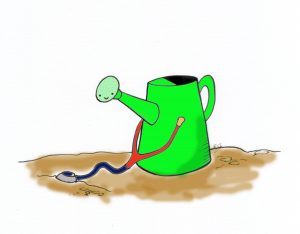Have you ever thought about what scary things are lurking in your soil? Me neither… until I started working at The Land Connection. Soil is one of those topics that just keeps surfacing here. It comes up in emails, at meetings, in project conversations. It’s everywhere! Growing fruits and vegetables seemed like a pretty simple process to me. You find the soil, put the seed in the soil, your plant grows, you pick the fruit or vegetable, and you eat. Nothing complicated there, right? BUT a few months ago an article came across my email that talked about the importance of soil health and soil testing before starting a garden. This is something that never even crossed my mind. Today’s edition of Grow With Me is actually about growing! After reading this I hope you all will reconsider the process for planting your garden because if you wouldn’t drive a car blindfolded, why would you eat fruits and vegetables from mystery soil?
 If you’re anything like me, springtime is the most exciting time of the year. You get your seeds planted and you are ready to watch those plants grow. You may have been so excited to plant that you skipped thinking through the soil you were planting your garden in. The key to growing great produce, though, is healthy soil and one step in determining whether your soil is healthy is to have the soil tested where you want to plant. Let’s face it, you haven’t lived on your land since the beginning of time, so the chances of knowing what has contributed to your soil is pretty slim. A soil test will let you know which vitamins and nutrients are present in your existing soil, pH, and texture. Results on these indicators will help you to choose what types of organic matter need to be added to your garden to restore it to a healthy state for a productive garden.
If you’re anything like me, springtime is the most exciting time of the year. You get your seeds planted and you are ready to watch those plants grow. You may have been so excited to plant that you skipped thinking through the soil you were planting your garden in. The key to growing great produce, though, is healthy soil and one step in determining whether your soil is healthy is to have the soil tested where you want to plant. Let’s face it, you haven’t lived on your land since the beginning of time, so the chances of knowing what has contributed to your soil is pretty slim. A soil test will let you know which vitamins and nutrients are present in your existing soil, pH, and texture. Results on these indicators will help you to choose what types of organic matter need to be added to your garden to restore it to a healthy state for a productive garden.
In addition to informing you about the above measurements, a soil test can also identify heavy metal contaminants in your garden. Since some heavy metals like lead and arsenic are a bit more dangerous for us to consume through food, you want to ensure the levels present in your soil are below the maximum consumption levels. Heavy metals are commonly found in soil due to:
- Naturally occurring in the earth
- Lead paint on old buildings
- Chemical fertilizers or pesticides
- Gasoline runoff or pollution from gas stations and mechanic shops
- Landfills
- Industrial factories and/or runoff from those factories
- Runoff from streets and parking lots
- Lead paint
- Treated lumber
- Air pollution
At this point you must be wondering how you can get your soil tested. There are home testing kits sold through stores like Lowe’s, Home Depot, and other garden centers. These tests require you to use tablets and vials to test the soil and then you compare your results against charts. If a home test is not appealing to you, the University of Illinois Extension Office has put together a great list of locations for you to contact that will do home soil testing. You can find that list at: http://extension.illinois.edu/soiltest/
Testing your soil is only the beginning of making a difference in your soil’s health. One of my key life discoveries in learning is that a basic understanding always requires more research. With soil testing, the next steps that would be important for an individual to research before truly making a difference in soil health are:
- How to read and analyze the soil test report
- What the process looks like to get your soil right
- A plan for maintaining healthy soil
I hope this brief blog provides you with the needed information to start making your garden plan for this spring. It will be here before we know it!


